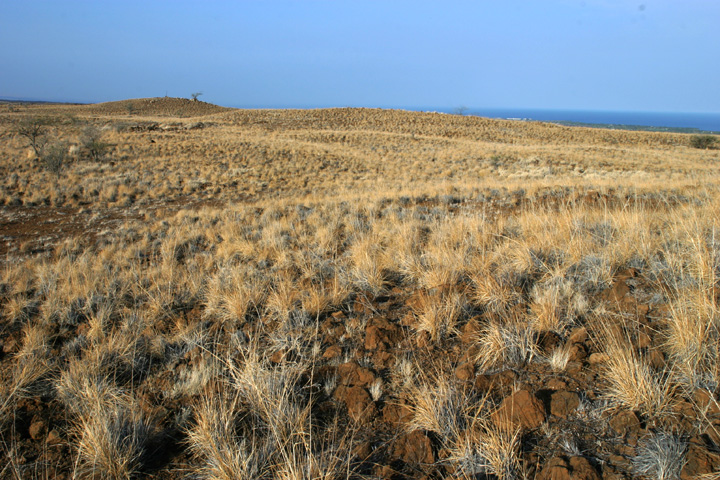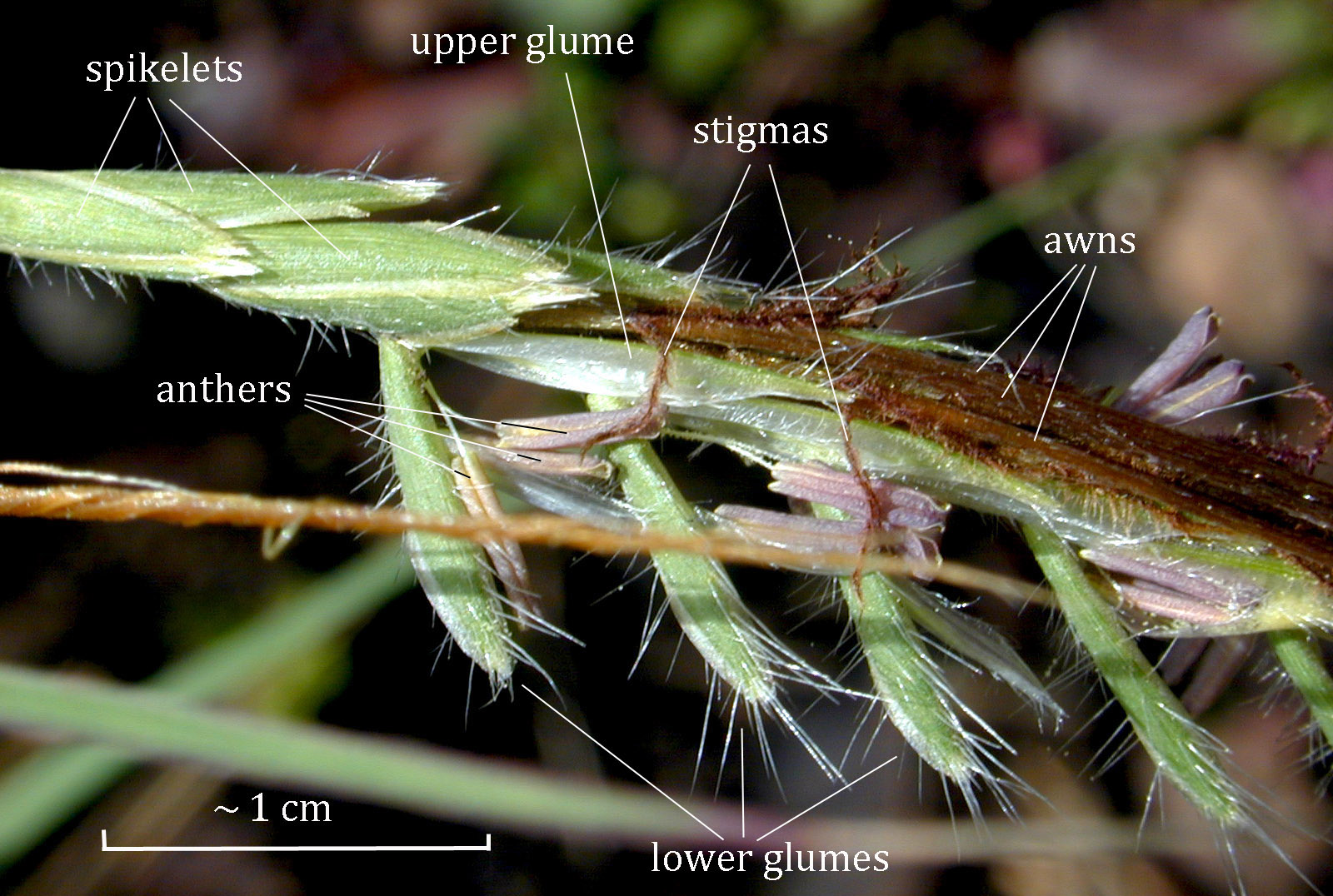|

Figure C. Field of native kāwelu (Eragrostis variabilis) in Kona (Moku o Kiawe) in the dry season.
Most people readily recognize members of the grass family because of certain common characteristics: creeping or clump-forming herbaceous plants with fibrous root systems, stems hollow between nodes, and long, narrow leaves (termed linear) arising singly from a stem node and having a basal part above that node clasping the stem. Of course deviations from this generalized description of the grass body occur; and there are plants that somewhat resemble grasses, but are not; examples: sedges (see Sedges) and some lilies like Mondo grass (Ophiopogon). While most grasses are herbaceous—that is, not woody—there are members of the family that are; these are the bamboos.
Plants that "flower" are classified on characteristics of their flower, and the generalized description of the vegetative structure provided above only helps us make an initial determination that we probably are or probably are not dealing with a grass when we encounter a plant we wish to identify. Our keys are designed to get you past any initial mistakes attempting to identify a plant that resembles, but is not, a grass . However, verifying a correct identification of any flowering plant is ultimately dependent upon characteristics of the flower; a specimen not in flower cannot be "identified" in most cases (although certainly might be "recognized"; see next paragraph). This admonishment does not mean you cannot become adept at recognizing many grasses when these are not bearing flowers, only that this key will prove useless without having a flowering head at your disposal. If you are new at attempting to identify grasses, an excellent website covering the basics is Grass Identification by Jean Turner.
Keys have been developed that rely not on details of the flower, but on vegetative characteristics only. The Vegetative Key to the Common Grasses of Hawai‘i (Morden and Caraway, 2000) is one such example. Others exist on the internet for places other than Hawai‘i, and typically have specific limitations (for lawn or turf grasses only, for example). These keys generally rely on characteristics of the grass leaf, particularly the point where the blade bends off the stem above the sheath (part wrapping around the stem), distribution of veins and hairs, shape of the tip of the leaf, as well as some characters of the grass stem (culm) and its nodes. Viewing many of these details can require a good magnifying lens or dissecting scope, and material brought in from the field must be fresh or properly mounted, and collected with a view to using the vegetative parts.
Freshness of material is not so important when examining grass flower structures, as these preserve well if simply allowed to dry out (although in some species, the flowers fall away at maturity). The key here utilizes various characteristics of each grass species, but can ultimately require looking at details of the flower structure. At a broader level, the general shape and arrangement of the flowers (the flower head) provide not just a relatively easy way to begin sorting out the many species, but can be used to differentiate grasses at the generic level. In the author's opinion, this approach provides more utility towards recognizing grasses in the field than does utilizing only vegetative characteristics.
Naturalists and field botanists develop a mental image—a sense of the gestalt—of a species that allows them to identify plants encountered without having to go through the process of keying out a species each and every time it is encountered. If you have read this far in the text, you very likely already have a sense of the gestalt of a grass. That is, you recognize a plant as a grass, or at least greatly resembling a grass. Although we would like to use the gross appearance (gestalt or, the official botanical term, habit) of a species so as not get too bogged down in microscopic structures, even a key to the most common species of grasses in Hawai‘i or Guam must rely at some point on such details to confirm an identification. If you wish to learn to identify a grass on sight in the field, you will need first to have knowledge of what other species are similar, and second, to confirm your sense of a species' appearance by working through the microscopic details of grass vegetatative, and particularly flower, structure.
A further caution is warranted here: plants of the same species can appear grossly (macroscopically) different, depending on the conditions under which they grow. A large grass may be small and straggly if grown under adverse conditions of say, poor soil or lack of moisture or too much shade. It is for this reason that botanists ultimately rely on microscopic features of the flower, as these characteristics are not so sensitive to the conditions under which the plant grew. A plant growing under poor conditions will produce fewer, but identical, flowers as the same species growing under ideal conditions.

Figure D. Close-up of the flowers of pili grass (Heteropogon contortus). Spikelets on left are closed, the flowers (florets) covered by the glumes. Spikelets on the right have opened in anthesis, exposing the flower parts (stamens and stigmas).
1 cm = 0.4 inch or ~3/8 in. Details on grass flower structure are provided on Page v.
|
|
|
And we say "microscopic" details because the characteristic of grasses that makes them difficult to differentiate—to identify separate from similar species—is having very, very small flowers (see Fig. D, above). Grass flowers are pollinated by wind, and do not require showy structures like petals to attract insects or other pollinators. The tiny flowers are arranged in structures (loosely termed a flower head or inflorescence), the form of which is an important consideration in moving through our key. At some point in the process of keying out a grass, you will need to resort to a broadfield (dissecting) microscope or a good hand lens. Our first challenge is to get you as far as possible towards a correct identification before resorting to a requirement of examining minute details of the grass flower, but learning the unique terminology associated with grass flower structure is a requirement for success.
A review of herbarium sheets and extensive field work has been greatly expanding the number of naturalized grass species found in Hawai‘i (Faccenda, 2022, 2023). It can be estimated that some 100 species have been added since the publishing of the Manual of Flowering Plants of Hawai‘i (Wagner, Herbst, and Sohmer, 1990; 1999)(see Imada, 2019). Faccenda added another 38 species in his two recent publications. With the advent of genetic sequencing, clarity is being achieved in a number of particularly difficult genera such as Sporobolis (Faccenda, Yorkston, & Morden, 2024). The keys presented herein can only attempt to keep up and apply all of this new information. Naturalists and field biologists (our intended audience) can go no deeper than the microscope will allow, but botanists in the lab and hebarium, working back from the genetic sequencing results, can cetainly improve our field observations.
|